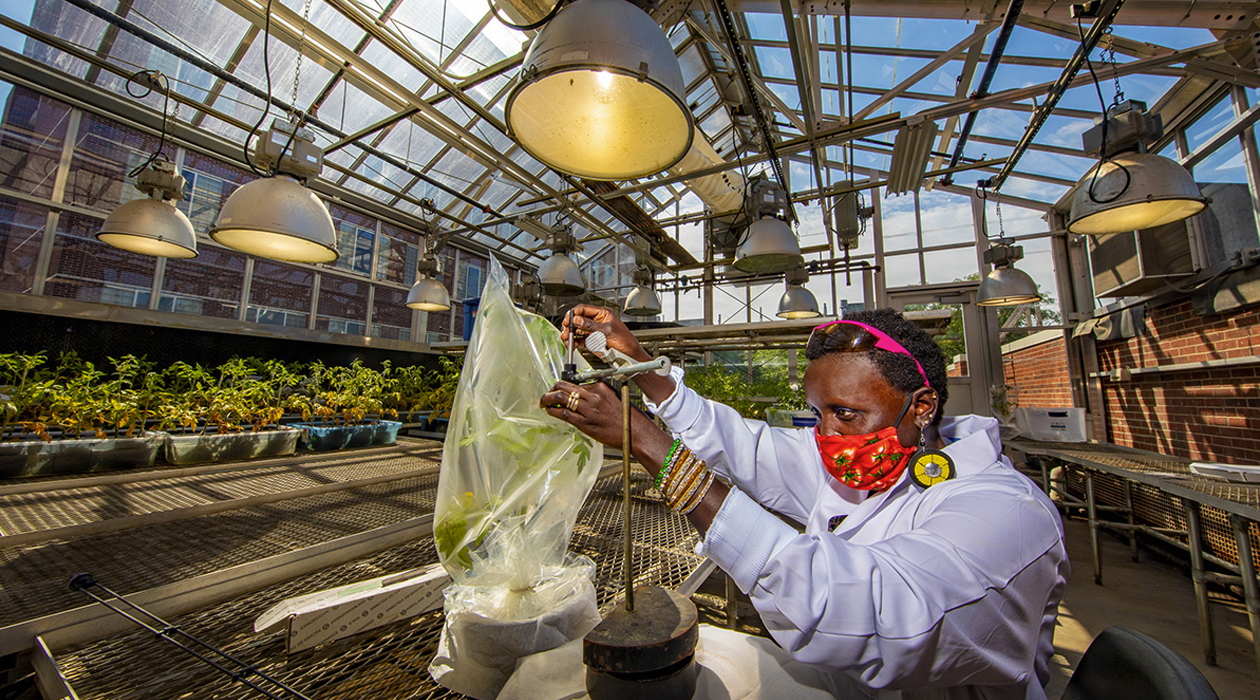Urbana, Illinois, USA
August 27, 2024
 Entomology professor Esther Ngumbi studies how two varieties of tomato plants and tobacco hornworm larvae respond to flooding. The hornworm caterpillars are enclosed in plastic bags affixed to the tomato plants. / Fred Zwicky
Entomology professor Esther Ngumbi studies how two varieties of tomato plants and tobacco hornworm larvae respond to flooding. The hornworm caterpillars are enclosed in plastic bags affixed to the tomato plants. / Fred Zwicky
I can barely hear Esther Ngumbi over the roar of greenhouse fans as she shows me around her rooftop laboratory in Morrill Hall. The benches are full of tomato plants, and the tomatoes don’t look good. Half of the plants are submerged in bins of water. Their leaves are yellow and withering. Some of the dying tomatoes have flowered. I see one or two baby tomatoes on a couple of spindly plants.
This isn’t the only torture inflicted on the tomatoes. Someone has tied little baggies to their stems. Inside the bags, fat green caterpillars are chowing down on the tomato leaves.
Entomology professor Ngumbi (CIS/GEGC/MMG) has questions — lots of them — and this is how she’s set out to answer some of them. She is purposely flooding the tomatoes to see how they might respond to flooded conditions in farmers’ fields — a scenario that is becoming more common as a result of climate change.
“In nature, there are many stressors on plants during flooding,” Ngumbi says. “Once the tomatoes get flooded, they’re already weak, so most likely they will be attracting insects, which like to eat weaker plants. We’re investigating how the plants deal with the combined stress of flooding and herbivory.”
This explains the caterpillars. They are the larval form of Manduca sexta, the tobacco hornworm. They are feasting on one of the two heirloom tomato varieties Ngumbi is using in the experiment: Cherokee purple and striped German.
Half of the tomato plants in the greenhouse are not flooded, allowing the team to compare the stressed plants with those grown in more common conditions. But there are more investigations going on here.
“Also, within this experiment, we’re looking at the microbes,” Ngumbi says. “We want to understand how the microbial community changes in flooded conditions.”
One of Ngumbi’s key focuses is how soil microbes influence plant health and productivity. She’s fascinated by mycorrhizal fungi, which form intimate associations with plant roots, offering essential elements like nitrogen to the plants in exchange for glucose supplied by the roots.
The tomato plants are all growing in soil from an Illinois farm, but half were also inoculated with mulch from a local farmer who has developed his own recipe for nurturing mycorrhizal fungi in the soil. Ngumbi wants to see if this inoculation makes any difference to the plants’ ability to defend themselves from the fat caterpillars.
To measure plant defenses, Ngumbi’s team collects samples of gases emitted by the plants and screens them for volatile organic compounds, the chemicals plants use to ward off bugs that would eat them.
Two years later, Ngumbi publishes the results of these and other laboratory experiments. She found that the two tomato varieties differed in gene expression and in the volatile compounds they emitted — before any intervention. And when flooded, both varieties of tomatoes had very different chemical emission profiles than when grown in normal conditions. Herbivory influenced the production of these volatile compounds, but not as much as flooding did.
Today, the experiments continue, and Ngumbi’s interest in the effects of flooding has only intensified. In a new review published in the journal Trends in Plant Research, she spells out the many changes that occur when plants are inundated with water for days or weeks at a time.
“Flooding is different from other climate-related stressors because it deprives plants of oxygen, an essential and indispensable element and substrate for plant growth and development,” Ngumbi writes. Flooding disrupts plant metabolism and energy generation. It interferes with photosynthesis. Flooding kills beneficial bacteria and promotes pathogenic microbes in the soil. It also can compromise plants’ ability to defend themselves from disease and harmful insects like the tobacco hornworm.
Ngumbi also warns that increased flooding can undermine decades of research aimed at making plants more resilient to climate change. Flooding may thwart efforts to build soil quality and microbial health to make crops more resilient to stressors such as heat and drought. Flooding also may eliminate gains derived from genetic engineering or plant breeding.
With flooding intensity and frequency predicted to increase by roughly 7% for every 1° C increase in global average temperatures, Ngumbi writes, scientists must consider the impacts of floods to “protect the monumental gains made in building climate-resilient crops.”
---
The paper “Flooding and herbivory: The effect of concurrent stress factors on plant volatile emissions and gene expression in two heirloom tomato varieties” is available online from the journal BMC Plant Biology.
DOI: 10.1186/s12870-022-03911-3
The review paper “Could flooding undermine progress in building climate-resilient crops?” is available online from the journal Trends in Plant Research.
DOI: 10.1016/j.tplants.2024.07.017